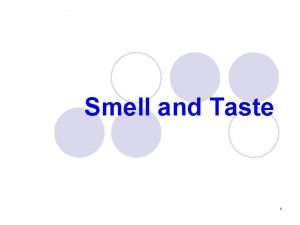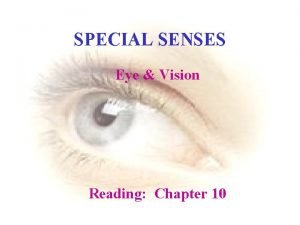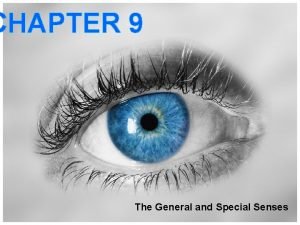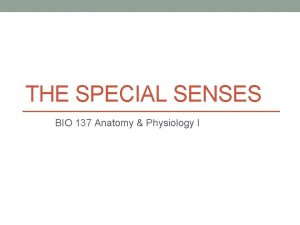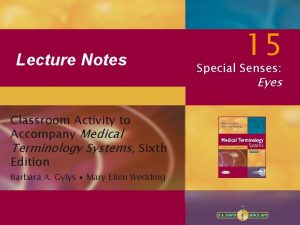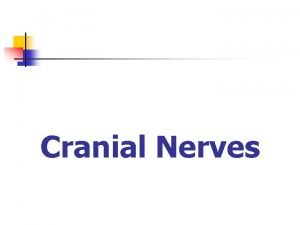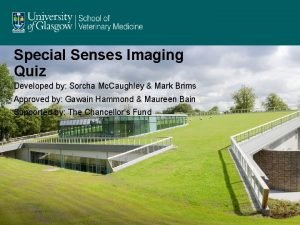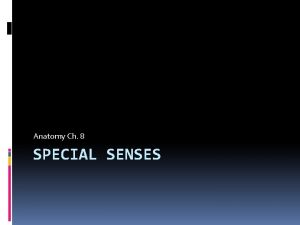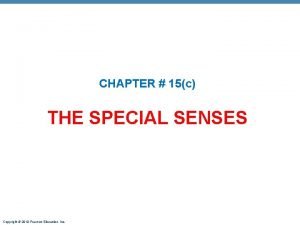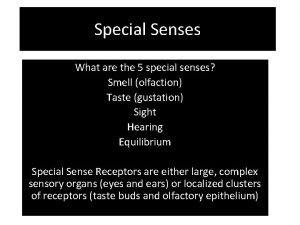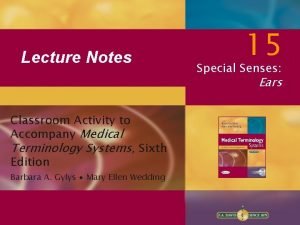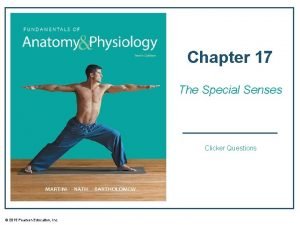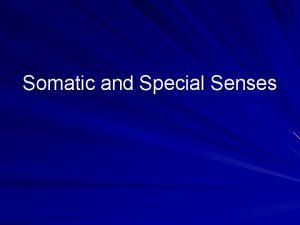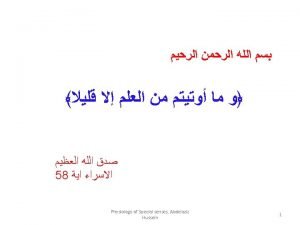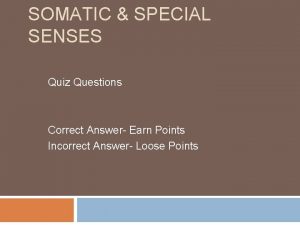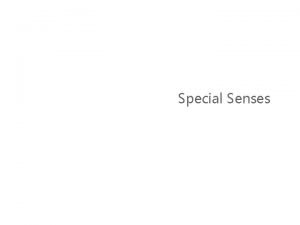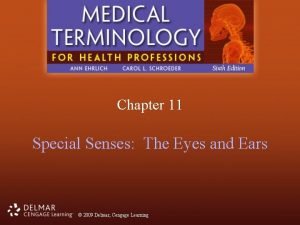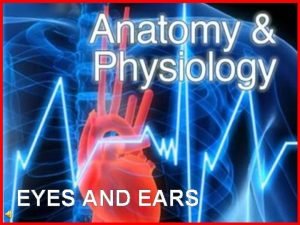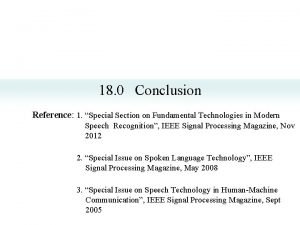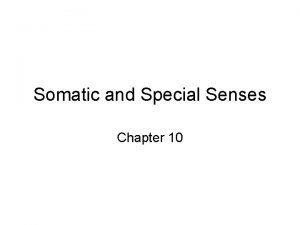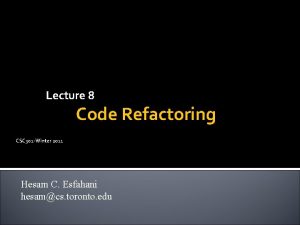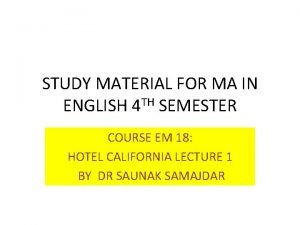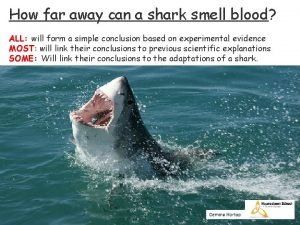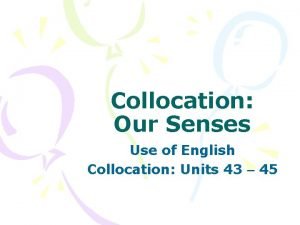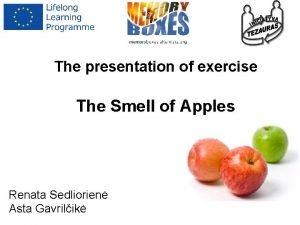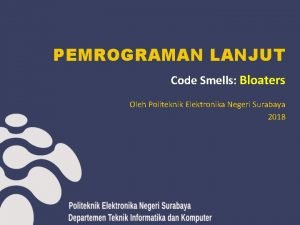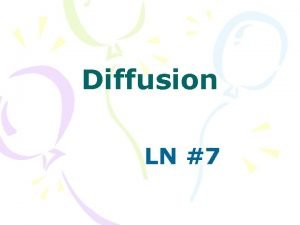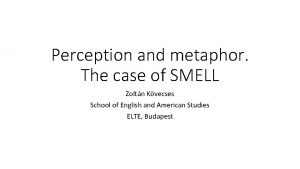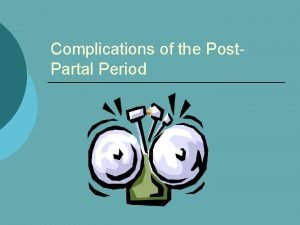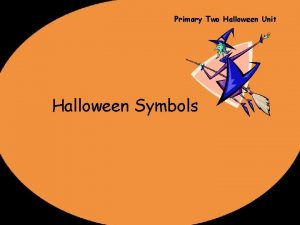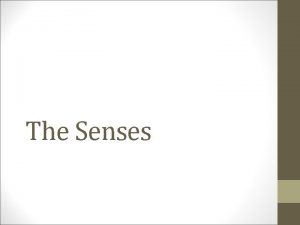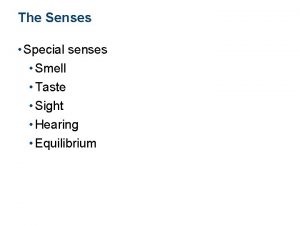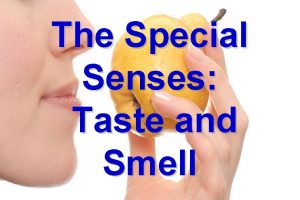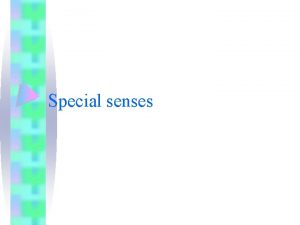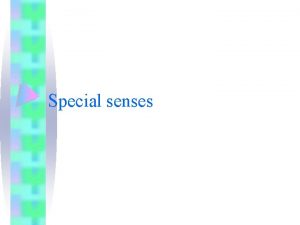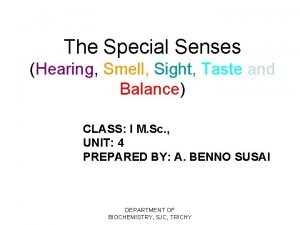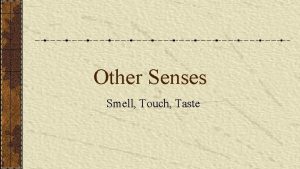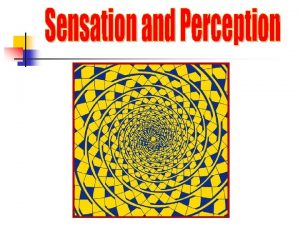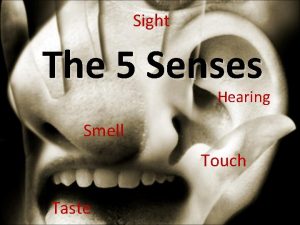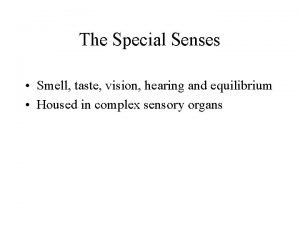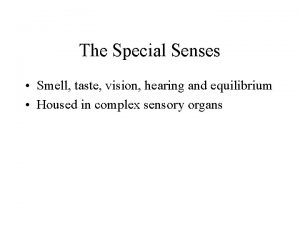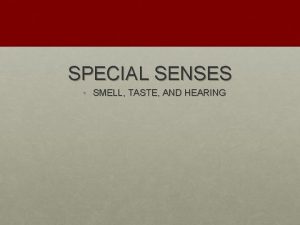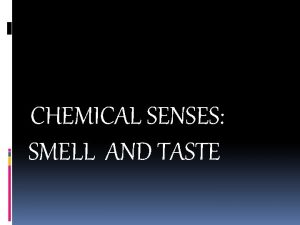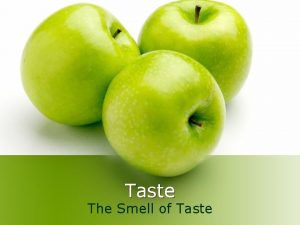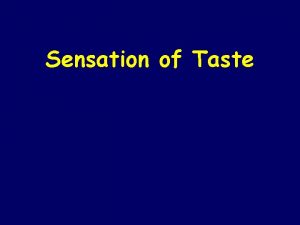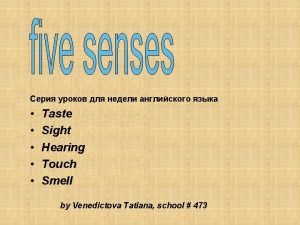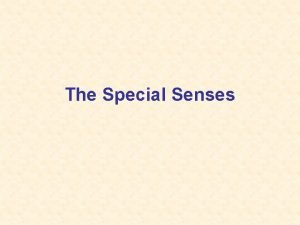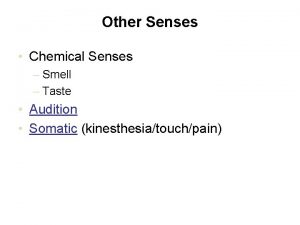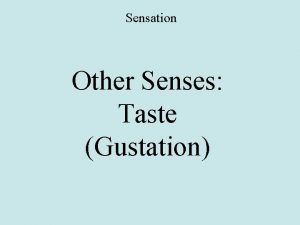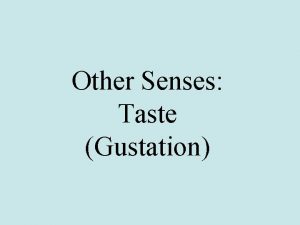The Senses Special senses Smell Taste Sight Hearing










































- Slides: 42

The Senses

Special senses Smell Taste Sight Hearing “Touch” = temperature + pressure + pain of skin, muscles, & joints • Equilibrium (in the ear) • • •

The General Senses • What are the Sensory Basics? • Sensory receptors—Specialized cells or cell processes that monitor external or internal conditions. Simplest are free nerve endings. • General versus Special Senses • General senses—Temperature, pain, touch, pressure, vibration, and proprioception. Receptors throughout the body • Special senses—Smell, taste, vision, balance, and hearing. Receptors located in sense organs (e. g. , ear, eye). Copyright © 2007 Pearson Education, Inc. , publishing as Benjamin Cummings

The General Senses • What is a Pain Definition? • Nociceptors—Receptors for tissue damage to lead to the sensation of pain • Temperature • Thermoreceptors detect temperature change • Cold receptors greatly outnumber warm receptors • Touch, Pressure, and Position • Mechanoreceptors—Receptors that respond to physical distortion of their cell membranes. • What are Baroreceptors? • Provide pressure information essential for autonomic regulation Copyright © 2007 Pearson Education, Inc. , publishing as Benjamin Cummings

The General Senses • Baroreceptors and the Regulation of Autonomic Functions Figure 9 -4

Sensory Receptors • Large complex organs (eyes, ears) • Localized clusters of receptors (taste buds, olfactory epithelium)

The General Senses • Referred Pain Figure 9 -2


Vision Tests

The Special Senses—Vision • What are the Accessory Structures of the Eye? • Eyelids (palpebra) and glands • Superficial epithelium of eye • Conjunctiva • Lacrimal apparatus • Tear production and removal • Extrinsic (outer) eye muscles Copyright © 2007 Pearson Education, Inc. , publishing as Benjamin Cummings

The Special Senses—Vision • What is the Lacrimal Apparatus? • Lacrimal gland produce tears • Tears drain into nasal cavity Copyright © 2007 Pearson Education, Inc. , publishing as Benjamin Cummings

The Special Senses—Vision • The Accessory Structures of the Eye Figure 9 -8(a)

The Special Senses—Vision • The Accessory Structures of the Eye Figure 9 -8(b)

The Special Senses—Vision • Image Formation Figure 9 -16(a)

The Special Senses—Vision • Image Formation Figure 9 -16(b)

The Special Senses—Vision • Visual Physiology • Photoreceptors—Cells specialized to respond to photons, packets of light energy • Two types of photoreceptors • Rods • Highly sensitive, non-color vision • Cones • Less sensitive, color vision • Site of sharpest vision Copyright © 2007 Pearson Education, Inc. , publishing as Benjamin Cummings

Are the squares inside the blue and yellow squares all the same color?

Bezold effect The smaller squares inside the blue and yellow squares are all the same color. They seem different (magenta and orange) because a color is perceived differently depending on its relation to adjacent colors (here blue or yellow depending on the outer square).

Are the horizontal lines straight or crooked?

Café Wall Illusion The horizontal lines are straight, even though they do not seem straight. In this illusion, the vertical zigzag patterns disrupt our horizontal perception.

Does Lincoln’s face look normal?

Some neurons in the brain seem specialized in processing faces. Faces are usually seen upright. When presented upside down, the brain no longer recognizes a picture of a face as a face but rather as an object. Neurons processing objects are different from those processing faces and not as specialized. As a consequence these neurons do not respond to face distortions as well. This explains why we miss the weird eyes when the face is inverted.

Can you see a baby?

Illusory Contour The baby’s head is on the left, the baby’s feet are against the trunk of the tree on the right. Illusory Contour: a form of visual illusion where contours are perceived without a luminance or color change across the contour

How quickly can you say the color of the words below?



Taste Tests


The Special Senses—Taste • What are Taste (Gustatory) Receptors? • Taste buds • Found within papillae on tongue, pharynx, larynx • Sense salt, sweet, sour, bitter Copyright © 2007 Pearson Education, Inc. , publishing as Benjamin Cummings

Flavor = taste + smell

5 Types of Taste Receptors

Aging • After age 50, ability to smell and taste decrease • Membranes lining nose become thinner & drier olfactory nerve deteriorate • # taste buds decrease with age more difficult to detect sweet/salty foods taste more bitter • As people age, their food tastes more bland eat less possible malnutrition

The Special Senses—Smell • What are Olfactory Organs? • Olfactory epithelium • Olfactory receptor cells • Neurons sensitive to odorants Copyright © 2007 Pearson Education, Inc. , publishing as Benjamin Cummings

The Special Senses—Smell • The Olfactory Organs Figure 9 -6(a)

The Special Senses • Key Note • Olfactory information is routed directly to the cerebrum, and olfactory stimuli have powerful effects on mood and behavior. Gustatory sensations are strongest and clearest when integrated with olfactory sensations. Copyright © 2007 Pearson Education, Inc. , publishing as Benjamin Cummings


Equilibrium and Hearing • What are Sensory Functions of the Inner Ear? • Dynamic equilibrium • Static equilibrium • Hearing What is the Anatomy of the Ear? External ear Pinna (auricle) External acoustic canal Tympanic membrane (eardrum) Middle ear Auditory ossicles Connect tympanic membrane to inner ear Auditory tube Connection to nasopharynx Copyright © 2007 Pearson Education, Inc. , publishing as Benjamin Cummings

Equilibrium and Hearing • What is the Anatomy of the Inner Ear? • Vestibule • Receptors for linear acceleration, gravity • Semicircular canal with ducts • Receptors for rotation • Cochlea with cochlear duct • Receptors for sound Copyright © 2007 Pearson Education, Inc. , publishing as Benjamin Cummings

Equilibrium and Hearing • The Anatomy of the Ear Figure 9 -22

Equilibrium and Hearing • Key Note • Balance and hearing both rely on hair cells. Which stimulus excites a particular group depends on the structure of the associated sense organ. In the semicircular ducts, fluid movement due to head rotation is sensed. In the utricle and saccule, shifts in the position of otoliths by gravity is sensed. In the cochlea, sound pressure waves distort the basilar membrane. Copyright © 2007 Pearson Education, Inc. , publishing as Benjamin Cummings

 Sight hearing taste smell and touch
Sight hearing taste smell and touch The chemical senses taste and smell review worksheet
The chemical senses taste and smell review worksheet What is the difference between somatic and special senses
What is the difference between somatic and special senses Messiners
Messiners Flow chart of taste and smell
Flow chart of taste and smell Epiglottis taste buds
Epiglottis taste buds Chapter 10 special senses
Chapter 10 special senses Anatomy and physiology chapter 8 special senses
Anatomy and physiology chapter 8 special senses The general and special senses chapter 9
The general and special senses chapter 9 Special senses physiology
Special senses physiology Building vocabulary activity: the special senses
Building vocabulary activity: the special senses Cranial nerve mnemonic
Cranial nerve mnemonic The general senses
The general senses Special senses quiz
Special senses quiz Chapter 8 special senses
Chapter 8 special senses Modiolus
Modiolus Five basic taste sensations
Five basic taste sensations Building vocabulary activity: the special senses
Building vocabulary activity: the special senses Chapter 17 special senses answer key
Chapter 17 special senses answer key Somatic senses
Somatic senses Extraocular muscles
Extraocular muscles The cones of the retina are coursera quiz answers
The cones of the retina are coursera quiz answers Chapter 15 special senses
Chapter 15 special senses Houses the receptors for hearing
Houses the receptors for hearing Assignment: 11.1 image labeling
Assignment: 11.1 image labeling Special senses the eyes and ears
Special senses the eyes and ears Signal conclusion
Signal conclusion Thermoreceptors
Thermoreceptors Bad smell name
Bad smell name Chemical properties of citric acid
Chemical properties of citric acid Warm smell of colitas definition
Warm smell of colitas definition Agraph smells blood
Agraph smells blood Smell collocation
Smell collocation Acetic acid smell
Acetic acid smell Carboxylic acid and alcohol
Carboxylic acid and alcohol Picture an apple in your mind
Picture an apple in your mind Code smell bloaters
Code smell bloaters Balloon smell
Balloon smell Connotation of smell
Connotation of smell Smell
Smell Postpartum hemorrhage treatment drugs
Postpartum hemorrhage treatment drugs Colours of halloween song
Colours of halloween song Melena smell
Melena smell




